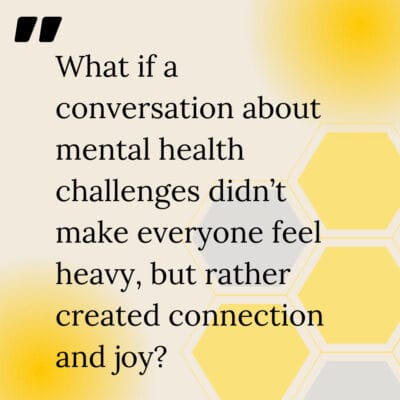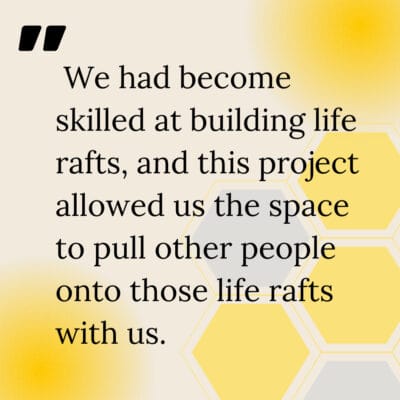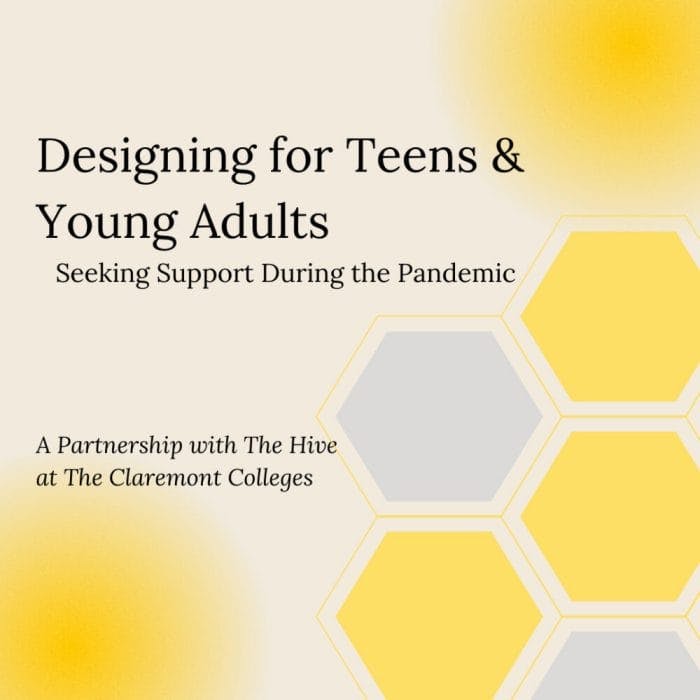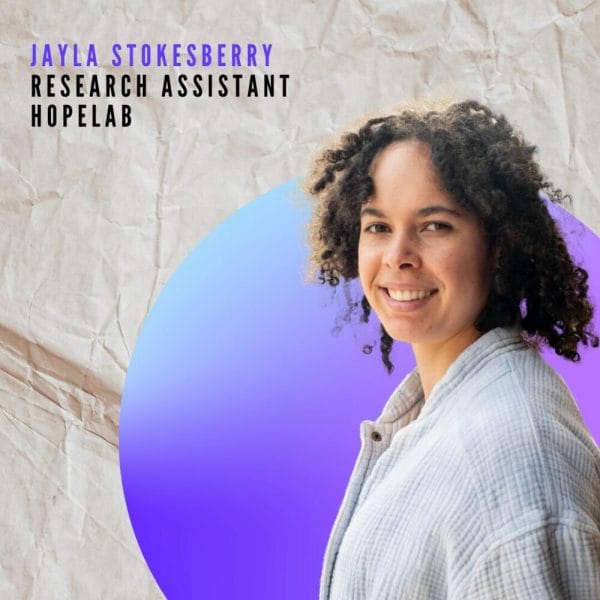Hopelab recently partnered with The Hive, a Human-Centered Design studio at the Claremont Colleges, to prototype mental health solutions from the perspective of college students themselves. At the end of the project, we connected with Ava Liao, a student in the class and rising junior, and Olivia Hewitt, a TA for the class and rising senior, to hear about their experiences going through the design process and collaborating with Hopelab on mental health.
Olivia: How can you tell if people are okay on Zoom? I scanned students’ faces for signs of stress or anxiety and clicked through the scrolling bar of Zoom boxes at the top of my screen, waiting for one of them to grimace, smile, or send me some sign of how they were doing in their Zoom box far away. I felt responsible for how they were doing, what they might be feeling, and felt I needed to find ways to alleviate the stress they may be feeling around the prompt.
Olivia: Throughout the course, Fred [Leichter] and I aimed to treat teaching the Human-Centered Design class as a design project in and of itself. The class was a prototype we were constantly testing and iterating on. Teaching the class online only amplified the need for adaptation, experimentation, and constant pivots. One of the guiding questions that Fred and I returned to over and over again was, “How might we create a Zoom class that feels like a dinner party with friends?” We wanted to act as good hosts, and create a space where there was a sense of community, where everyone felt comfortable, and where people could laugh, share stories, and dive into interesting conversation.
Ava: Studying from home—especially in a different time zone—means that you have to adapt to a lot of factors that aren’t part of a typical college experience. I feel like most people would agree that it’s difficult to pay attention for extended periods of time on Zoom, and I think I’m lucky to have had professors who’ve implemented different teaching strategies. Fred and Olivia came up with so many different warmups and activities to engage us through the screen, and it worked really well.
The Project
Hopelab approached our Human-Centered Design class with the prompt: “In a distanced world and in the midst of a global pandemic, how might we aid teens and young adults in their quest for mental health and well-being?”
Olivia: Fred and I were nervous to pitch this project to the class. To ask a class of college students to dive into a design challenge around mental health in the midst of a global pandemic as many of us are struggling with our own mental health, felt like a really big ask.
We had to trust that the Human-Centered Design process would do its magic—speak to universal themes and address challenges that are widely felt by diving deep into the individual experience. The goal was not to design mental health challenges away, or to create a solution that would work for everyone. The goal was to listen deeply and understand one single person’s experience, and design something that might positively impact their life, in a big or small way.
Ava: My team wanted to create something that could genuinely have an impact and improve some aspect of quarantine life. User interviews were really important to us, and I think we set out initially to try and center user experiences in the project as much as possible. It’s difficult to gather hard statistics on something so emotional and personal, so we tried to look for common threads when it came to gathering insights. A lot of people felt unmotivated and socially isolated, and thought that accessing mental health resources wasn’t worth the time or effort to try and access.
We had a few false starts when it came to designing a potential solution. We used “how might we…” models to generate ideas, but most of the concepts we produced tended to address only a small aspect of our users’ needs, or none at all. We had a Hopelab check-in session around this time, which served as a much-needed reminder for us to circle back to our original interviews to understand why we were doing this work in the first place.
Olivia: A framework that is central to the Human-Centered Design practice is “embracing ambiguity.” As a TA for this class, and throughout this final project, I had to remind myself of the value of these words. I had to find ways to lean into the messiness, the uncertainty, and trust that we would all come out the other end with insights and energy.
The Product
Ava: I think the highlight of this project for me was our final presentation. We had prototyped an app called Ketchup (“catch up”), and designed it to sync schedules between friends so that they could cook and eat together without hassle, simulating the atmosphere during mealtimes at college. We had created it as a solution for a college student on a leave of absence, who feels isolated from her college friends and community because of the pandemic.
We all felt like it’d be impossible to come up with a prototype that we could present remotely while also immersing our audience. We ended up writing a four-page script with Mario characters and audience interaction, and rehearsed our skit with the help of Zoom filters and props sourced from our home kitchens.
Olivia: I’m going to remember the day of the final presentations for a long time. Fred and I expected the students to produce incredible work, but we didn’t expect to laugh so hard, to smile so wide, to feel such joy in the final presentations on such a heavy topic. It reminds me of two classic frameworks for HCD: “explore an opposite,” and “challenge an assumption.” What if a conversation about mental health challenges didn’t make everyone feel heavy, but rather created connection and joy?

During the final presentations, one of the student teams found an innovative way for us all to experience the prototype they’d designed. They asked all of us in the audience to go find a sweatshirt or towel, and keep them ready next to us. When the time came, they instructed us to drape our towels over our heads and hang them over the edges of our computer screens, creating what felt like a mini blanket fort for each of us.
Nestled deep within the adaptation, there was joy. We held our towels and sweatshirts and blankets over our heads, leaned in towards our Zoom cameras, and began to laugh. In twenty-three different living rooms across the world, we had found a way to feel close. To be honest. To see that what we were designing towards were not solutions, but rather beginnings.
Reflections
Olivia: Design is messy. Designing for mental health can be challenging, scary and overwhelming. But by diving deep into the topics that consume us, we also find a way to let the light in. By listening closely to someone else’s story, we might find parallels and connections to our own lives. It was scary to ask students to take the plunge into the topic of mental health. I kept looking to see if they were okay, if they needed life rafts, and many times I didn’t know.
Ava: Addressing and improving mental health doesn’t necessarily have to be a tangible, institutional intervention: this project showed us that subtle, indirect solutions work just as well. We learned from our interviews early on that nutrition and routine are big factors in sustaining mental health. Food nourishes both physical and mental wellbeing, and we often don’t realize it.
Olivia: It wasn’t about diving into the deep waters alone. It was about taking each other’s hands, being honest, and cheering when something worked. As I watched the zoom chat overflow with exclamation points and heart reacts, I realized that I wasn’t the only one scanning people’s faces to make sure they were okay. Everyone else in the class was doing that too. There was a network of young people reaching out their hands, offering their stories, and bringing light and laughter into dark and familiar places.

Navigating mental health in the midst of a pandemic was a problem space we were deeply familiar with, uncomfortably familiar with at times. But that familiarity meant we had been designing solutions, big and small, for over a year. We had become skilled at building life rafts, and this project allowed us the space to pull other people onto those life rafts with us.
About the Contributors
Olivia Hewitt is a senior at Pitzer College where she’s majoring in Human-Centered Design. She loves to listen to and tell stories through visual design, written word, or audio (and is especially excited when multiple mediums are combined). In her free time, you can find her skateboarding, drinking coffee, and trying to understand how to make better Spotify playlists because she’s currently very mediocre at it.
Ava Liao is a junior at Claremont McKenna College studying UI/UX design. In her free time, Ava enjoys playing around with video game UI, reading about medieval history, and trying to perfect her homemade bubble tea recipe.




